Lime flour composition. Methods for using dolomite flour in agrotechnology. What plants do not need a dolomite flour
Growing plants by panstone It is impossible without feeding and maintaining soil acidity.
If you were lucky enough to become the owner of alkaline soils, then these problems are unfamiliar. Otherwise, you need to deal with the acidity of the soil and maintain its required level. You can do this with the help of lime or dolomite flour.
What does Lime know, probably, every gardener, but the dolomite flour is not familiar with everyone. Dolomite flour is obtained by crushing the mineral substance (dolomite) to the powder state. Its cost is relatively low, and useful qualities allow you to widely apply this substance.
Properties of dolomite flour
The ability of this product to neutralize the acidity and enrich the Earth with valuable substances ensured its use in many areas of the economy. Its composition is rich in magnesium and potassium. They are indispensable for the full development of colors, grain and vegetable crops, various berries, fruit trees.
But, in addition to the ability to regulate the level of pH of the soil, that is, it is ideally suitable for the formation and development of plants, the dolomitic flour has a number of other beneficial properties. She is:
- improves soil consistency;
- favorably affects the development of useful microorganisms in the ground, which are healing it;
- regular use of powdered dolomite enriches the top layer of soil easily digestible elements - nitrogen, phosphorus and potassium;
- enhances the useful effect and digestibility of mineral fertilizers (phosphorus, nitrogen, molybdenum);
- makes a crop environmentally friendly because it cleans plants from radionuclides;
- satures the soil by magnesium, without which photosenthesis of plants is impossible;
- increases efficiency from the use of organic fertilizers;
- destroys pests by corrosive their chitin coating, while this mineral does not affect other living organisms.
Application of dolomite flour
Dolomitic flour acts as an assistant both gardeners and gardeners and flowerflowers. Its rich composition allows it to be made in both open ground and greenhouses. It is indispensable on the sandy and sandy soils deprived of magnesium, vital for plants.
Before the start of the use of dolomite, it is necessary to check the acidity of the Earth using the Lacmus paper.
If the level of acidity is increased, then it is necessary to adjust its composition. If the pH level is below 4.5, the flour is made in the calculation of about 600 grams per meter square plot. If the soil of the average acidity (pH within 4.5-5.2), then 500 grams will be enough.
If your site is characterized by weak acidity (pH above 5.2), That optimally will contribute to 400 grams of dolomite flour per square. Be sure to follow the recommended dosages, otherwise you can change the structure of the soil not for the better.
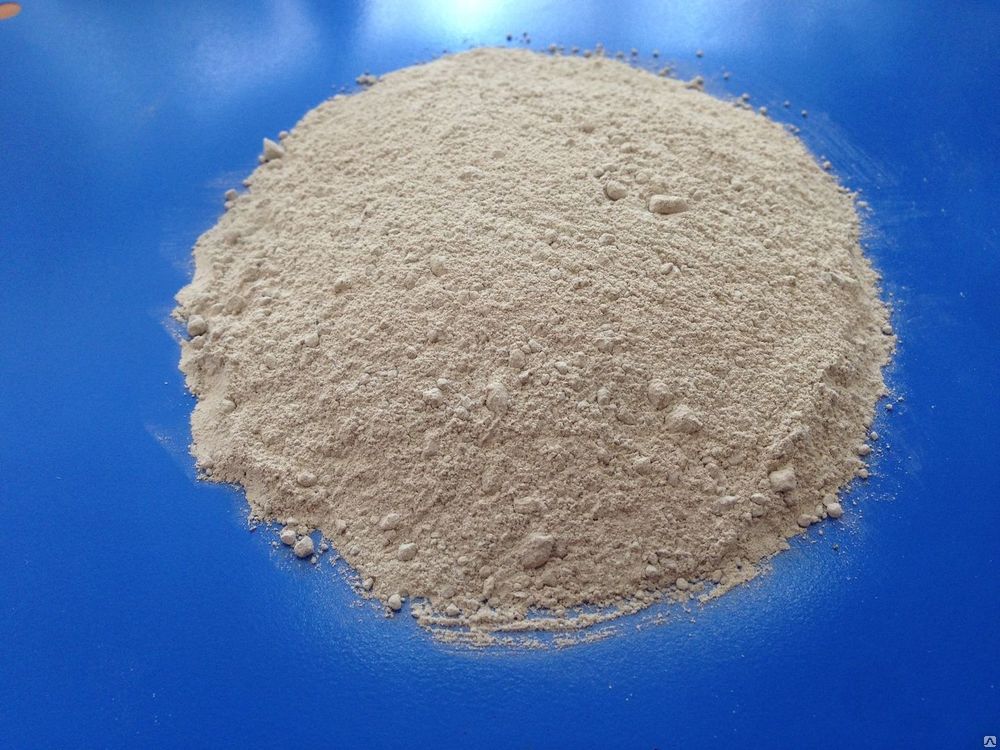
Dolomite can be introduced together with the organica, for example, by manure. From it you can prepare lime milk, which is better absorbed by some plants than the direct deposited dolomite flour.
For example, beets reacts to the fertilizer with lime milk increase in yield, its leaves become saturated green.
Another way to use dolomite flour is the limestation of trees and bushes. Conduct this procedure obo one every two years. It will help to overcome unnecessary pests.
Apply dolomite flourIt is important to know that it does not combine with ammonium nitrate, urea and superphosphate.
Lime is a generalized name of the products obtained after burning and processing carbonate rocks. There are three types of its varieties, but the harated lime is used by special demand.
It is obtained as a result of dilution with water oxide calcium. It is important to know that it is not desirable to use hot waterSince as a result you will get fewer beneficial substances.
Properties Lime
Lime contains calcium - an indispensable element to maintain the vital activity of plants. This element performs such tasks:
![]()
- Supports the immunity of plants and relieves them from a variety of diseases, caused by calcium deficiency.
- The limestation of the soil activates the reproduction and functioning of nodule bacteria. These organisms help to delay in the nitrogen soil obtained from the air in the process of soil looser. As a result root system It is powered by nitrogen in sufficient quantities and, accordingly, all the plant receives nutrients.
- Improving the propagation process of carbohydrates on plant tissues. Calcium improves the solubility of elements in aquatic space.
- Activation of useful bacteria when creating compost pits. Calcium contained in lime contributes to the development of these organisms, and they, in turn, identify nitrogen from the organic matter and mineralize it. Also, calcium helps the formation of humus, since accelerates the process of decomposition of organic substances.
- Maintain a neutral level of pH in the soil. Lime interrupts the toxic effect of heavy metals.
- Improving the structure of the soil. Lime binds her and, as a result, the Earth becomes more commoted, not a bulk.
Application of lime

Lime is also the main element to normalize the degree of soil acidity. Oxidation must be carried out once every 5 years. In case the site is very actively operated, - once every 3 years.
It is important to analyze the state of the soil, since it often flashes the change in the composition. Your plot can turn green moss, wormwood or horsetail. So urgently need to be loving.
Fullly this procedure is carried out in autumn. In the spring, only partial treatment of the site is allowed using large number Lime. And then, the time interval of seven days should be observed before planting plants and seeds.
How often it also depends on what other fertilizers you use. If only mineral, then limeting is rapidly.
Natural fertilizers (with regular use) themselves cope with the maintenance of the neutral pH of the soil. Therefore, fertilizer lime may be superfluous.
This product is used to protect the trees from pests by paving the trunks. This procedure is very effective and completely inexpensive. Trees can be blued both in spring and autumn. It all depends on the preferences of the gardener.
What is better lime or dolomite flour
It is impossible to unequivocally argue about the championship of lime or dolomite flour. But it is worth noting that the composition of dolomite flour is enriched with calcium by 8% more compared to lime. This element contributes to the formation of the root system and improves the structure of the soil.
And one more significant point - dolomite contains about 40% of magnesium, which is absent in the composition of the lime. Magnesium is contained in chlorophyll, without which the photosenthesis of plants cannot fully pass.
With magnesium deficiency, the growth and development of shoots slows down, the leaves are premature and falling and falling, the plant is infected with chlorose and brown spotting, with which it is very problematic.
Dolomitic flour - a fertilizer in the form of a powder, which is produced from the Dolomite mineral relating to the class of carbonates (formula - Caco3 MGCO3) by grinding it to the smallest fractions. The introduction of this fertilizer in the soil not only normalizes its acidity, but also improves the structure of the upper fertile horizon, simply enriching its useful trace elements, such as magnesium and potassium. Also, the dolomite flour helps to reduce the number of weeds on the site, and the activation of the activities of the beneficial microorganisms and unobtinka (ringed) worms. Another advantage is available, as its price is low, and it is possible to buy this mineral fertilizer of natural origin in the containers of any volume, based on personal needs.
Since this mineral feeding has a natural origin, it is additionally not saturated with various additives, and is used in pure form. This makes it possible to attribute it to a high environmental class of use, and draw conclusions that the use of dolomite flour is not harmful to human health. Calcium and magnesium are in its composition in carbonate form, which prevents their deposits and accumulation in the finished fruit and vegetable products in too large quantities.
Properties
As mentioned above, the dolomitic flour, the composition of which includes calcium and magnesium, significantly affects the composition of the soil, changing its acidity.

But, except for the ability to deoxine the soil - that is, it is to bring it composition to the values \u200b\u200bmost suitable for growing various plants, dolomitic flour has a number of other advantages. She is:
- Improves the structure of the soil;
- Contributes to the development of colonies of microorganisms in the soil improved;
- If you bring a dolomite flour permanently, it satures the top layer of the Earth easily digestible nitrogen, phosphorus and potassium;
- Increases the return on imaginary mineral fertilizers;
- Increases the content of calcium and magnesium in the soil;
- Helps plants to cleanse radionuclides;
- Destroys insects, dissolving their chitinous cover. For all other living beings, dolomite is fully safe.
Determination of soil acidity
So as not to be mistaken with the amount of dolomite flour introduced, before applying fertilizer, it is necessary to determine the acidity of the soil. This can be done with the help of many ways, here are the most accessible and popular of them:
Weighing plants
Weeds, as well as cultural plantswill not grow on the soil that does not suit them in their acidity. Therefore, they are a kind of indicator indicating the pH factor soil mixture Location on. For example, on the weakly acidic soils, dandelions, drinking, chamomile, clover and mother and-stepmother are growing. On acidic - moc., Plantain, buttercup, and on neutral - flip and nettle.
Vinegar
The use of this table sauce is one simplest and fast ways To establish the norms of making dolomite flour. It is used so - the handful of soil is watered with several drops of vinegar and look at the reaction. If the earth begins to swell and bubble, then its pH reaction is neutral or sour.
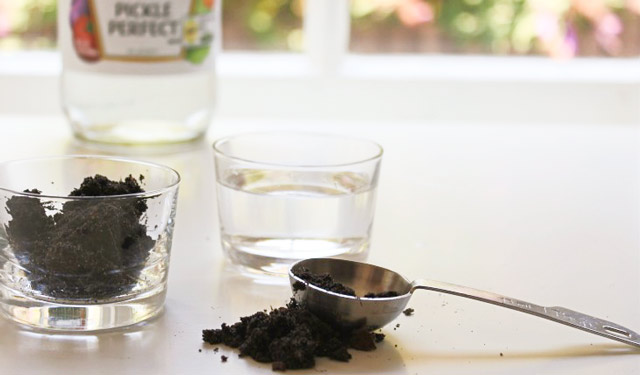
Grape juice
This natural ingredient is used as follows: Pose of the Earth in a container with juice, and if the juice changes its color, and bubbles - soil has a neutral reaction on the surface of the liquid.
Special instruments
From a sufficiently large number of specialized devices that produce both foreign and domestic manufacturers, the following models of digital and analog portable pH meters can be recommended for private use. These are non-volatile EPA-102 and EPA-103, manufactured in Brazil, and HI-9025 and HI-9024, digital portable devices, the production of Germany, which ensure high measurement accuracy. You can also apply a simple lactium paper.
Video: Determination of soil acidity with Lacmus paper
Dolomite or lime - what to choose?
For the deoxidation of the soil, in addition to the dolomite flour, it is very often used by the haired lime (Ca (OH)), which the people are called "Pushonka". It is more often found on sale, and it is cheaper than the dolomite powder. But does she exceed it in consumer properties?

Limestone flour is considered the strongest means for the normalization of soil acidity. Calcium enters its composition in the form of hydroxide (in contrast to dolomite, as part of which Ca is included in the form of carbonate), which increases its effect on the acidity of the soil, reinforcing its ability to neutralize it one and a half times.
Lime "works" faster and more active, but this property has the negative sides. For example, at first after the application, it prevents the assimilation of the most necessary substances for plants, such as phosphorus and nitrogen. Therefore, immediately after its introduction it is impossible to plant anything, the land should "relax." Therefore, lime flour is usually made in the offseason, when the beds are prepared under winter, or in early springTo ensure a good gap before seed landing and seedlings.
Unlike lime, dolomite can be made at any time as soon as the need arises. Therefore, it has become one of the most popular fertilizers normalizing the acidic environment of the soil.
Application of dolomite flour
Dolomite flour is always used only after the soil acidity accurately determined, otherwise it can significantly harm the plants, up to their complete destruction. The general instructions for the use of dolomite flour looks like this:
- At the pH of the soil factor, which is less than 4.5, it is considered acidic. 50 kg of dolomite flour per 1 weaving contribute to such soil.
- At pH, equal to 4.5-5.2, the soil is considered an average, and the rate of application of this mineral fertilizer is about 45 kg per 1 weaving.
- Weakly acidic soils, with a pH reaction from 5.2 to 5.7 units, fertilize the dolomite powder at the rate of 35-40 kg per weave.
Also, the amount of fertilizer introduced depends on the structure of the soil. On the pulmonary soils, the use of dolomite flour is reduced by 1.5 times, and on heavy, drunken and alumina, on the contrary, increase, by 10-15%, to normalize their structure.
When you are going to buy a dolomite flour to fertilize the beds, a garden or lawn, all these nuances must be considered when calculating. It can be purchased both in the store and order on the Internet. This fertilizer has a different packaging, it is sold in bags, packages and embankment. To prevent all the land on cottage plot Six acres with an area of \u200b\u200b300 kg. Considering that The price of one bag weighing 50 kg, according to the prices of leading suppliers for the spring of 2015, does not exceed 200 rubles, That completely fertilize the entire area is possible for 1200 rubles. Given the dolomite flour not more than once in three or four years, the price of the issue is more than acceptable, because all this time the soil will bring good yieldsAnd does not scatter.
Dolomite flour is also included in compost, both in simple and in its biologically active form - vermicompost. Worms, launched into the untreated humus, cannot live in a compost with an inappropriate pH reaction, therefore, for their comfortable existence, which causes their active reproduction, accelerating in turn, the processing of the organicities should be made to the bourge gross domit. It will provide the necessary level of acidity.
When to make?
As mentioned above, dolomite fertilizers can be used at any time of the year, as they do not have a negative impact on the assimilation of others nutrients Of the soil. But, usually they are brought before applying other fertilizers, since the dolomite flour does not interact organically with all of them.

On a plot intended for growing vegetables, it is scattered in the spring in advance, in a couple of weeks before landing. It not only fertures and improves the structure of the soil, but also squeezes it. It is very relevant for different cultures, including for which often amazed various diseasesWhose emergence and distribution dolomite can stop. Also for potatoes it is especially important that this mineral destroys insects, dissolving their chitinic shells at joints. It helps to fight the Medveda, Colorad beetle and other pests of potatoes.
Dolomitic flour, the use of which has a sanitating effect on the soil, is particularly relevant in the spring, as mineral dressing for plants of closed soil. When processing the soil, this mineral in the greenhouse does not apply various fungal diseases, which has a positive effect on the crop, and on the subsequent preservation of the obtained fruits and berries.
In the fall, this mineral feeder is used to process and feed fruit trees and shrubs. In this case, the following changes in the soil are recommended - for a tree - about 2 kg, along the edge of the rolling circle, shut down to the ground for shrubs (depending on the size) - 0.5-1 kg along the same scheme.
Calmization is a term that is often used to describe the soil fertilizer by rocks containing calcium. This is not always true, since different substances have a different effect on plants. Therefore, before proceeding to the improvement of the soil by the normalization of its pH -Factor, it is necessary to carefully examine the instructions for the use of fertilizer intended for this purpose, since the excess C and all its compounds are much more harmful than its disadvantage.
Video: Using Dolomite flour on the cottage
receive high yields and chic flowering plants Helps correctly selected soil. To do this, it is necessary to determine its composition. In this article we will tell you how it can be done on your own in the country or in the apartment and change the structure of the soil.
Dolomitic flour
Mineral with a crystal structure is called dolomite. It has a glass glitter and can have a different color: brown, reddish, white, gray.
If this mineral is grinding, then flour will turn out, which contains calcium, magnesium.
Pros and Cons for Plants
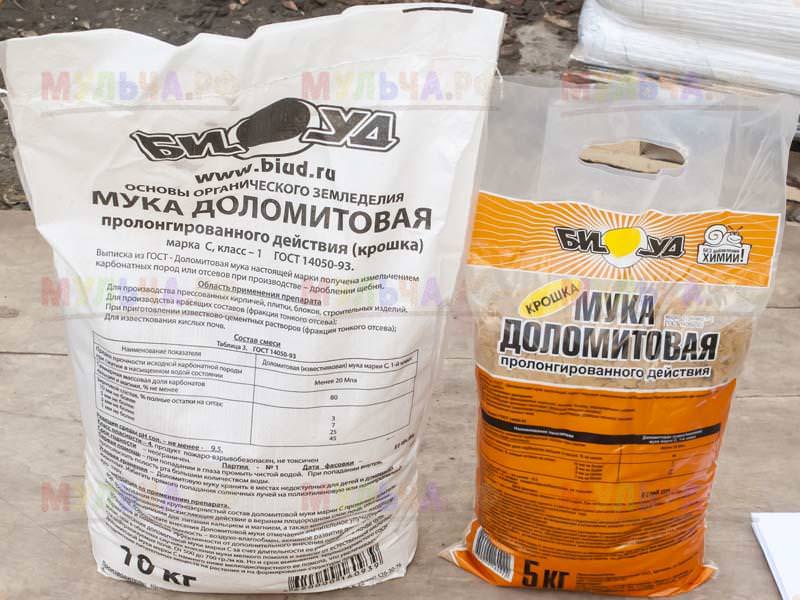 When making flour to the ground, the plant has advantages:
When making flour to the ground, the plant has advantages:
- Gets food.
- Better develops.
- Helps the plant to fight pests.
- Vintage quality.
- The shelf life of fruit increases.
- Neutralized radionuclides.
- Participates in photosynthesis of plants.
- The root system is improved due to calcium in the soil.
- Increases the effectiveness of applied fertilizers.
- The plant gets molybdenum, nitrogen, potassium, phosphorus.
- Affordable price.
Disadvantages:
- Fits not all plants.
- Overdose is dangerous.
Application
- Dolomite flour is used in construction, gardening, flower growing, glass and sugar industries, metallurgy.
- The product acts as a natural mineral fertilizer that does not require different additives.
- Agriculture applies flour in various spheres. Since it is normalized by its introduction and the composition of soil composition with nutrients is improved.
- If the soil is neutral, then the flour is not worth added, in this situation, it is used as effective tool In the fight against pests.
- A wide application of Dolomitic flour received as fertilizer due to the available price and shelf life, which has no limit.
Lime
Pros and Cons for Plants
Pros:
- An exemption in the soil is an excellent assistant in the fight against diseases, as it contains calcium, which increases the immunity of plants.
- Lime primer is a stimulant for the development and functioning of nodule bacteria. They, in turn, delay nitrogen in the ground, which falls from ambient During weeding. It means that the root system takes the normal amount of nitrogen and useful substances are transferred to the entire plant.
- In plant tissues, the plants are perfectly distributed carbon. Since it contributes to calcium, which helps dissolve elements in the aqueous structure.
- When compost pits are created, the useful bacteria activities are active.. This contributes to the calcium content in lime. Organisms contribute to the release of nitrogen from the organic matter with subsequent mineralization of it. The formation of humus is also due to calcium. In this case, it acts as an accelerator of the decomposition process of organic elements.
- The neutral composition of the pH is maintained in the ground. Since the toxicity of heavy metals is interrupted by the removal.
- The structure of the soil is changing and becomes a lump, disappears its flowability.
Disadvantages:
- The minus for plants is the furthest lime, which is harmful to microorganisms in the ground.
- If you send it to a wet land, the process of quenching, hence its consequences.
- Inadmissibility of overdose.
Application
Lime normalizes soil acidity. It should be made 1 time in 5 years. With active operation, the procedure is made more often, after three years. Set the logging frequency by means of soil analysis. In this case, you can use the indicator, a special device or to establish its acidity with the help of grape juice and acetic essence.

Making lime to the soil
If the soil is covered with an eye, wormwood or green moss - This is a signal to make lime without any determination of acidity.
Good time for this is autumn.
Partial processing is carried out in spring. That is, during this period of time it is necessary to make a small amount of lime. The procedure is made 7 days before planting seeds or seedlings.
On the incidence of lime is influenced by the delivered fertilizers. Suppose, only used mineral fertilizersIn this case, the lime will be more often.
Again, if natural fertilizers are natural, then they themselves regulate the neutrality of the soil, without additional lime.
Lime is treated treesWhat is protected from pests. Usually, gardeners make it in autumn and spring.
What's better?
There is no definite answer when choosing dolomite flour or lime. But if we talk about the composition of calcium in products, then in lime it is 8% less. But it is it that improves the structure of the soil and forms the root system.
Next element magnesium. Part lime is he Excluded, but in dolomite flour, the content reaches it up to 40%. Full passage of photosynthesis of plants passes due to the content of magnesium in chlorophyll.
Magnesium deficiency affects:
- On the development and slowdown in the growth of shoots.
- There is probability to get brown spot and chlorosis.
- On premature falling leaves.
Gardeners, for example, repel from the culture that will grow on the soil. In their opinion, if potatoes are planted, it is better to apply a dolomite flour. Since the Parenic family adores magnesium, which helps to fight a pair. The causative agent of this disease is a radiant fungus. A favorable medium for it is soil with saturated calcium.
How to determine the acidity of the soil?
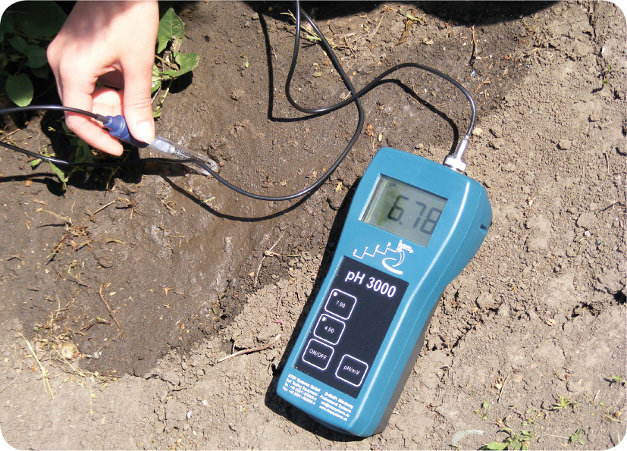
There are universal fertilizers who have natural origins. With them, the harvest in the garden will always be good and environmentally friendly. One of these feeding is a dolomitic flour, which is made from rock. How to correctly use Dolomite flour?
What is a dolomite flour?
Dolomitic (limestone) flour - this is a gridden dolomite belonging to the carbonate group mountain breeds. It is produced according to GOST 14050-93, according to which the particles do not exceed 2.5 mm; It is allowed to have fractions to 5 mm, but not more than 7%. The limestone flour is widely used on household plots for the deoxidation of soils and combating insects having chitinous cover. For other living organisms, the tool is safe. But nevertheless, flour contains extremely small particles, work with it should be carried out in glacial weather, as far as possible protecting their eyes and respiratory tract.
Photo Gallery: Dolomite path - from the mountain to the garden plot
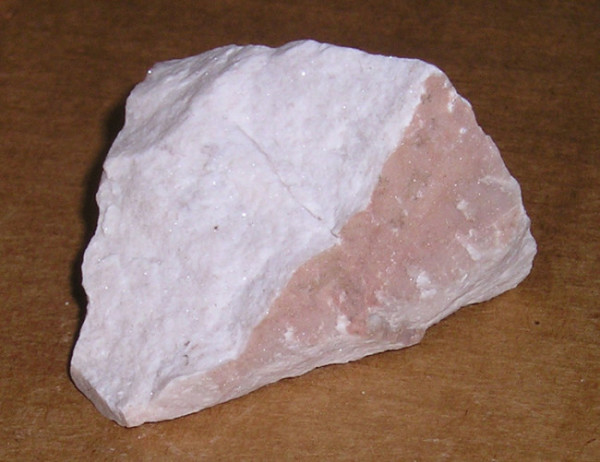
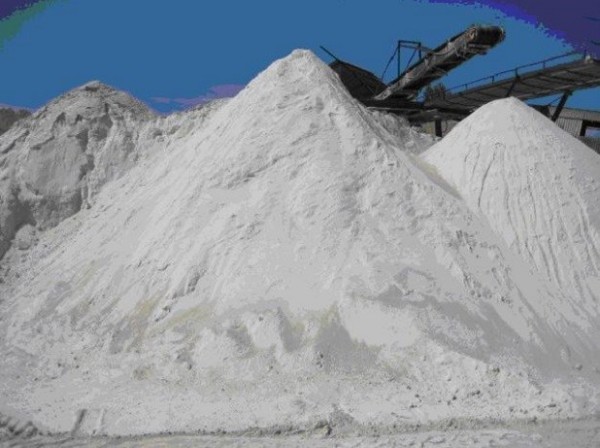

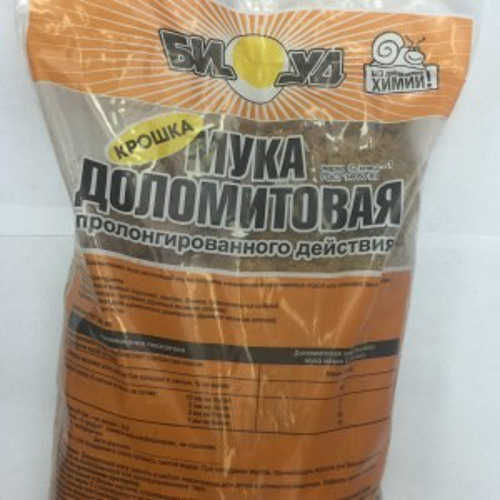
Dolomitic flour sold in stores, packaged 5 or 10 kg, has white or grey colour. In its production, third-party chemical elementsSince dolomite is useful in itself.
The smaller the particles of dolomite flour, the higher its quality.
Table: Advantages and Disadvantages of Dolomite Flour
Table: Chemical composition of dolomite flour
The percentage of moisture in the dolomite flour is allowed within 1.5%.
Recommendations for the use of fertilizer depending on the type of soil
The rules for making dolomite flour depend on the chemical and biological composition of the soil in the country or the preservation site. On one square meter Requires:
- - with acidic soil (pH less than 4.5) - 600 g,
- - with medium-sized soil (pH 4.6-5) - 500 g,
- - with weakly acid soil (pH 5.1-5.6) - 350 g.
For maximum effect, limestone flour is evenly distributed throughout the section and mixed with soil (approximately 15 cm from the top layer). You can simply scatter the remedy for the ridges, in which case it will start not earlier than in a year. Dolomite does not burn the leaves of plants. Its action with the right doses is 8 years.
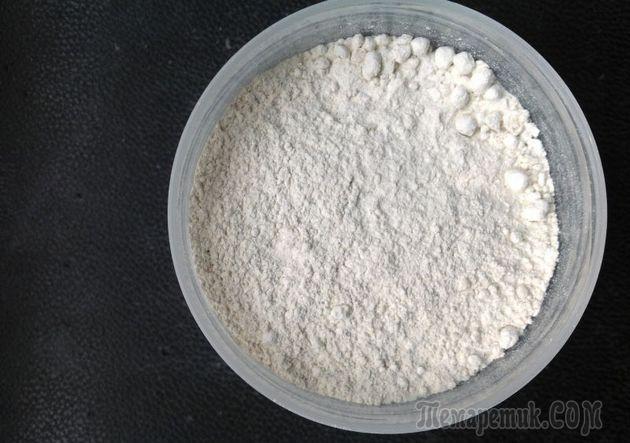
Making dolomite flour on the ridge is best to do in the fall
There are plants that grow on sour soils and therefore may die from the presence in the soil of dolomite flour. According to responsiveness, such fertilizer culture is divided into four main groups:
- Do not tolerate acidic soils, plants grow well on neutral and alkaline, react positively to making dolomite even on weakly acidic soils. Such cultures include: alfalfa, all types of coarse and cabbage.
- Sensitive to acidic soil. Plants of this group prefer neutral soils and are positively responding to the introduction of limestone flour even on the weakness of the soil. It is barley, wheat, corn, soybean, beans, peas, beans, clover, cucumbers, onions, salad.
- Weakly sensitive to acidity change. Such cultures grow well and in acidic, and in alkaline soils. Nevertheless, they react positively to making dolomite flour in the recommended norms with sour and weakness sooth. This is rye, oats, millet, buckwheat, Timofeevka, Radish, carrots, tomato.
- Plants that need lime only with increased soil acidity. Potatoes, for example, when making dolomite flour without recommended quantity potash fertilizer It may get sick, the starch content in the tubers is reduced, and the flax may become calcium chlorose.
Table: Rules for making dolomite flour
Under the rest garden crops Dolomite is made two weeks before landing in quantities depending on the acidity of the soil. Dolomitic flour in greenhouses is distributed over the ridges in the amount of 200 g per 1 sq.m. Only unlike open soil Soil in this case is not drunk. Dolomite creates a moisture film.
There are two most popular soil lime methods. They are named by the names of their agronomist developers:
- Metlider method. Instruction: per 1 kg of dolomite flour takes 8 g of powder boric acid, Distributed for ridges, drippy. After a week, minerals contribute chemical fertilizers And again dripping. Suitable for open soil.
- Method of Makuni. Mix 2 liters of soils from the ridge, 2 liters of a special substrate for a certain culture, which is preparing for landing, 2l moss of sphagnum, 1 liter of river sand, 4 liters of peat, then add 30 g of Dolomite flour first, then as much double superphosphate And two glasses of crushed charcoal, mix everything thoroughly. Suitable for cooking soils under room flowers or for growing crops in greenhouses and oranges.
Table: Dolomite flour compatibility with various fertilizers
Fertilizers incompatible with limestone flour should be used no earlier than 10 days after making dolomite.
Video: Dolomite flour in agriculture
Surgent tricks on the use of fertilizer
- If the soil is on the clay site, dolomite contribute annually. In other cases, it is used once every three years.
- Fertilizer is better to make in the fall in order for the soil to resist and have been appropriate with all the useful elements.
- In the spring or at the beginning of the summer, plants can be watering a mixture of water and dolomite flour (200 g per 10 liters of water).
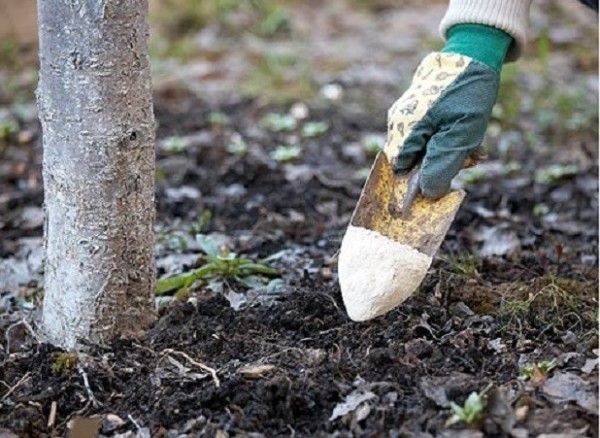
Dolomitic flour under the trees is made around the perimeter of the near-break circle
Analogs of means for use in the garden
Dolomitic flour is not the only means that can be used to deoxine soil, it can be replaced by other compositions.
Also successfully used to reduce the acidity of the soil. But here you need to take into account the type of wood from which the ash was made, to calculate the required amount for deoxidation is very difficult, especially on large areas. In any case, its consumption is several times higher than that of Dolomite, therefore, the procedure is obtained costly.
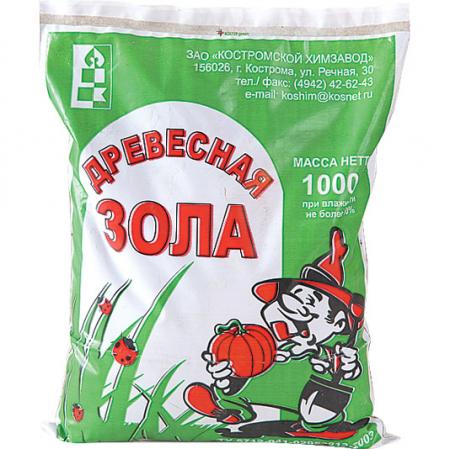
Wood ash - costly soil dealer
Lime (Pushonka). It is very active, quickly leads to the neutralization of the soil, prevents the cultures to sufficiently absorb phosphorus and nitrogen, so the lime is better to make in the fall under the pext. In no case, it can not be poured on the plant - Pushonka causes burns of leaves. AND the magnificent lime promotion leads to serious damage to the roots.

Lime causes burns on the leaves and roots of plants
Thanks to Dolomite flour, you can get a safe, delicious, rich harvest. It is economical but effective method Enrich the soil of the garden of the garden with useful trace elements, and it is not necessary to be afraid of damage to the plants.
Most of the crops grown in gardening seats are sensitive to the quality of the soil. It is possible to regularly receive abundant yields, only if the soil is neutral or weakly alkaline. Sour soil For agriculture fits badly, therefore the acidity before landings is neutralized. A suitable means for this is a dolomite flour, but in the use of fertilizer there are nuances.
What is a dolomite flour?
Dolomitic flour is the chopped to the powder state of Mineral Dolomite. Since it is found very often in Russia, there are no problems with raw materials. The finished powder is slightly glittering, its color varies from white to grayish, sometimes it can even be reddish or beige depending on the initial raw material.
Dolomite in high concentration contains calcium and magnesium carbonates, efficiently neutralizing soil acidity, which causes its benefit to agriculture. These same substances are present in the dolomite flour not in pure form, but in the form of salts, which prevents the deposition of trace elements in grown vegetables, berries and fruits in excessive concentration.
Dolomitic flour can be used as fertilizer. In the process of purely mechanical processing, chemical additives are not made, the agent is used in kind. Therefore, such fertilizer is completely safe and for ecology, and for human health.
The thinner of the grinding, the higher the quality of the fertilizer. It is for this that you need to focus when it is purchased. It is best for the vegetable heat tool, the granules of which do not exceed 1 mm in diameter (similar to the sea sand).
Please note that the dolomite may be non-indentible and burned. The advantage of the second option is that the landing will receive more magnesium.
Photo Gallery: Source Raw Machine and Mechanical Processing Product

Packaging with dolomite flour sold in stores
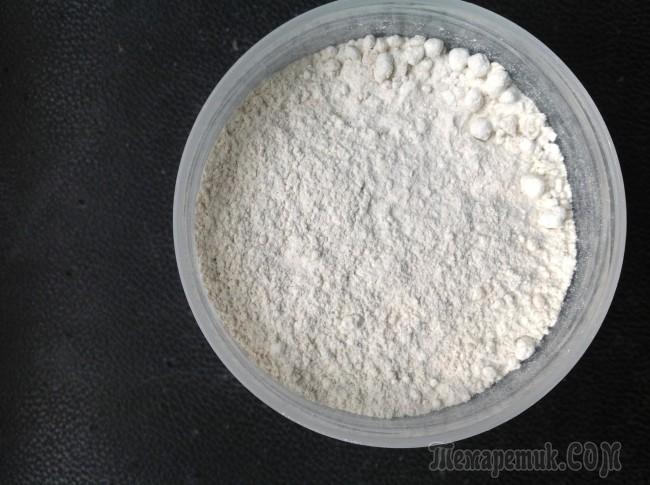
Mineral after grinding
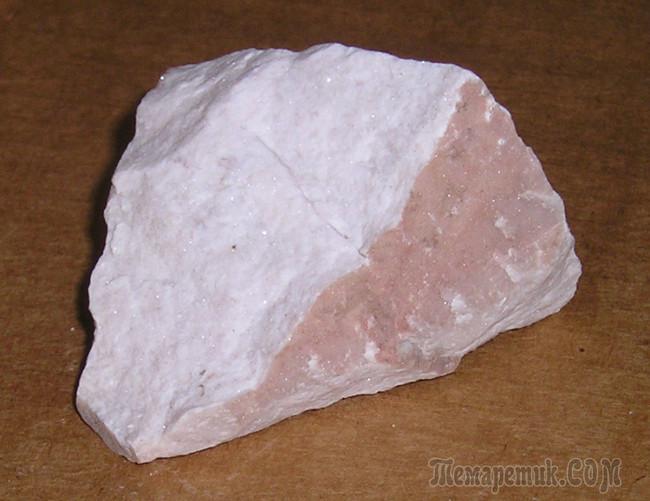
Mineral in kind
Useful properties for garden and garden
Dolomitic flour is excellent fertilizer that helps consistently get harvest, regardless of the quality of the soil.
But the benefits of this fund is not limited to the deoxidation of the soil. In addition to the fact that due to the increase in the concentration of calcium and magnesium, fertility increases in an easily-friendly form and the soil structure is improved, the use of fertilizer has other positive effects:
- The number of weed plants is reduced on the gardening area.
- Inhabable microorganisms useful for plants, bacteria and insects get a promotion incentive.
- The effect of other fertilizer-contributed fertilizers (chemical or natural) becomes more noticeable.
- Sharply decreases the number of pests. Powder particles play the role of abrasive, damaging chitinous cover of beetles and soft slick tissues. By the way, the flour can not only be buried in the soil, but also sprinkle the trunks, branches, stems and leaves. For people and pets tools absolutely safely.
- Fruits receiving less damage to pests are much better stored.
- The landing is good forgive, since the roots in the presence of calcium are growing faster and become stronger. The plant better opposes various infections (especially rot) and gets more nutrients from soil.
- Environmental purity of grown vegetables, berries and fruits. Dolomitic flour has a unique feature Neutralize salt-departed salts of heavy metals, even radionuclides.
- Magnesium coming into the fertilizer is needed to form chlorophyll, without which photosynthesis is impossible.
When to make?
Dolomite flour can be made to the soil at any time, as quality improvement and additional soil rehanging will never be superfluous.
Table: Recommendations for making dolomite flour depending on the time of year
| Deadline | Recommendations |
| Spring (15-20 days before the landing of a certain culture) - April-May | Dolomite flour scatter in a garden or a plot designed for specific landings, most often - under vegetable crops. Fertilizer is used not only for open soil, but also for greenhouses. Such a procedure helps to prevent the spread of mold, rot and other plant diseases caused by fungi. |
| Autumn (after harvest) - from the end of August to the end of October | The flour scatter around fruit trees, a mentally delineating circle of about 2 m in diameter, and intensively loosen the Earth. For one tree, 1.5-2 kg is enough. When fertilizing shrubs and norm, and the deposit area is doubled. |
| Winter - February-March | Flour can be scattered in the snow in winter, in the spring when it is to melt, the fertilizer has absorbed into the ground. But this procedure is effective only on a certain area. It must be relatively smooth (let's say a bias of 5-7º) and covered with loose snow. If the thickness of the snow cover exceeds 25-30 cm, the benefit from dolomite flour will not be. Similarly, if a strong wind is marked on the site. Fertilizer just blows up to spring. The tool must be completely dry, otherwise it will quickly grow out. |
| Summer | During the entire period of vegetation, the Dolomitic flour is good feeding and means to combat pests. Observing the rate of application, it is possible to process landing times in 4-6 weeks. |
| Combined option. | If a large pashnya area is processed, 2/3 of the flavors are made to the ground when it is planned in the fall, and the remaining third is in the spring when re-spindle. |
Nuances of making and applying fertilizers
Dolomitic flour will be useful to you only if the soil is really sour. In order not to spend in vain my own time, strength and money, first find out if you need such fertilizer at all. There are special devices and lactium paper for this. But on garden plot The high accuracy of measurements provided by them is not needed. Understand whether the soil can be understood using time proven folk remedies - acetic essence and grape juice.
Immediately it should be noted that with the uncontrolled scattering of Dolomite flour on the site of high yields should not be expected.
Treatment of the entire area of \u200b\u200bthe site and open soil
If the entire area is processed, the procedure must be carried out once every 6-9 years, depending on the level of the soil acidity indicator, the number of mineral fertilizers introduced and the intensity of precipitation. Flour is scattered over the site, roll up with rakes, and then dripped the ground to the depth of at least one bayonet shovel.
Dropping is necessary that fertilizer began to act faster. Otherwise, it will have to wait for rains that, absorbing in the soil, will deliver useful substances at. By the way, it rains all the fertilizers from the soil, including dolomite flour.
Blowing to the land of dolomite flour will give a greater effect than the fertilizer left on the surface
Be prepared for the fact that the positive effect will not appear immediately. The composition of the soil will be the best in 2-3 years. Then the action of dolomite flour gradually will begin to go to no. Due to energy efficiency and high fertilizer consumption, this method of deoxidation of the soil is used quite rarely.
How to use dolomite flour in greenhouses?
There are no obstacles to the use of dolomite flour in greenhouses, greenhouses and oranges. On average, 1 m² you need about 100 g. But in contrast to open soil, scattering fertilizer throughout the garden area, the land is not drunk. Flour creates a thin film on the surface of the soil, which holds inside moisture, not allowing it to evaporate. Thus, the upper layer of the Earth does not dry.
Instructions for use for individual beds in the country
Another option is to handle concrete beds, where it is planned to plant the culture soil sensitive to the acidity, or the roasting zone of trees and shrubs. Dolomitic flour is introduced into the wells when landing, in beds when leaving or crumbles at the roots (then the soil must be well inserted). But the actual question arises: how many dolomite flour will need?
If the soil on the beds are heavy (peat, ironsist, clay, sublinous, alumina), the corresponding norm increases by about 15%. It is recommended to annually contribute to dolomite flour.
For light sandy and sampling soils in beds, the norm is reduced by about a third. Enough one procedure with an interval in 3-4 years. In this case, considerably less fertilizer and acid-alkaline balance is maintained at the same level due to the regular receipt of new portions of the desired substances.
The amount of dolomite flour directly depends on the type of soil
Making dolomite flour into neutral and alkaline soil is urgently not recommended.You can disrupt the natural acid-alkaline balance. Excess calcium - a much more serious problem than the lack of this trace element.
Table: The rate of making dolomite flour depending on the soil
Video: Making dolomite flour in bed and landing
What agricultural crops do Dolomitic flour need?
Different plants react to acidic soil in different ways. Some of them, increased acidity rates are very suitable. Therefore, before scattering Dolomite flour in beds, find out whether such a fertilizer needs this culture.
Table: Type of soil and different agricultural crops
| Type of soil | What is best growing |
| Sour | Sorrel, gooseberry, cranberry, blueberries. |
| Moderately sour | Radish, radish, Daikon, Lon, cereals (millet, rye), buckwheat. |
| Weakness | Clover, alfalfa, cucumbers, corn, spinach, all varieties of leaf lettuce, carrots, soy, cereals (wheat, barley), potatoes, Bulgarian and hot peppers, eggplants, tomatoes. |
| Neutral | All types of cabbage, turnip, swallow, any legumes (beans, peas, beans, lentils), Espartz, onions, garlic, strawberries. |
| Alkaline | Black currant, bone trees (cherries, plums, apricots, peaches). |
And a few more comments:
- Cultures preferring moderately acidic and weakly acidic soils will respond on making dolomite flour by an increase in harvest.
- Under plants preferring alkaline soils, the means is entered into the root zone every fall, the recommended dose increases by 10-15% compared with the number of fertilizer when landing. If you try a new tree or bush, make a fertilizer in the well. About 0.1 kg, seedling of seeds (pears, apple) - 0.3 kg, bone seedlock - 0.5 kg.
- If the flour is needed by vegetable and berry cultures, it is put in the wells or furrows for seeds and immediately put the landing. This is especially concerned with winds and cabbage. Exception - tomatoes, potatoes and strawberries (fertilizer must be made in the soil in advance, in the fall or early spring).
- Dolomitic flour increases the yield of any winter crops, such as onions and garlic. You need this tool is also perennial colors and decorative plants.
Do not neglect the introduction of dolomite flour by landing or in the process of growing trees and shrubs
Compatible with other fertilizers
Table: Dolomite Flour Compatibility with Other Fertilizers
| Fertilizer | Recommendations |
| Solution copper Kaper and boric acid powder. | The effect of use and flour, and the specified means increases with simultaneous mapping. Make a mixture. On 1 kg of dolomite flour, 10 g of boric acid powder or a 5 l 0.05% solution of copper sulfate (25 ml per specified water volume) will be needed. |
| Any kind of manure bird litter and compost. | You can only conduct consistent processing. First scatter flour, then decompose the manure or litter and only then retER. The usual portion of the means can be reduced twice (manure - up to 2-3 kg / m², flour - up to 0.1-0.3 kg / m²). Feelable soil with a mixture of flour and manure is strictly prohibited. |
| Any chemical fertilizers containing nitrogen and phosphorus (ammonium nitrate, urea, superphosphate simple, double, granulated, ammonium sulfate). | To mix them with a dolomite flour in no case, a chemical reaction may occur. Imagined with an interval of about 7-10 days, these funds complement each other perfectly. Moreover, nitrogen acidifies the soil, so the dolomite flour is needed. |
- Methyder method. 7-8 g of boric acid powder takes 1 kg of dolomite flour. This mixture is scattered in beds after harvesting, then the soil is drunk. The rate of 1 p / m is 200 g, if the soil is heavy or peat, and twice as smaller, if the light sandy. After 5-7 days, mineral fertilizers containing potassium, phosphorus, nitrogen are additionally made. The garden is once again drunk.
- Method B. M. Makuni. The method is also suitable for open soil, but more often used for greenhouses, greenhouses, room colors and seedlings. Mix 2 liters of soils from the garden, special soil for the culture, which is expected to grow, and moss-sphagnum, 4 liters of peat, 1 l of large river sand. Separately add 30 grams of dolomite flour and double superphosphate and two glasses of chopped in wood coal powder. Everyone is thoroughly mixed.
What can replace the dolomite flour?
The function of deoxidation of the soil In addition to the dolomite flour, extinguished lime and wood ash. But the first tool compared to them has a number of advantages.
Haashed lime costs a little cheaper, and it can be purchased at any construction store. But this is only calcium, and not in the form of carbonate, but as hydroxide. Such a chemical compound is 1.5-2 times more efficient to neutralize the increased acidity of the soil, respectively, the flow rate is reduced. However, it acts too sharply and strongly. In the case of even a small overdose, agricultural crops are guaranteed to suffer - you just burn the roots.
Calcium hydroxide also neutralizes soil acidity
In addition, calcium hydroxide cannot be made in the soil immediately before landings - it will prevent plants to assimilate the nitrogen, potassium and phosphorus contained in the soil or in fertilizers. Processing is possible only in the fall, when the crop is completely assembled, or at the very beginning of spring (in the southern regions where snow comes early).
Wood ash, like Dolomitic flour, no harm to the soil is not allowed at any time. In addition to calcium, the ash contains other substances needed for the soil - magnesium, phosphorus, potassium, and so on.
Wood ash sold, but in small packages
But it is problematic to use ash for deoxidation of a large garden of the garden. On free sale there are only packaging of a small amount. And since on the unit area, the consumption of ash exceeds the consumption of dolomite flour by about twice, most often the right amount in the economy is not located. Acquire ashes every year - quite expensive.
Dolomitic flour is a means that, with proper use, will allow steadily to obtain high yields and maintain grown fruits for the winter. In addition, it is safe for people, animal and the environment.